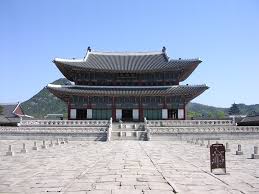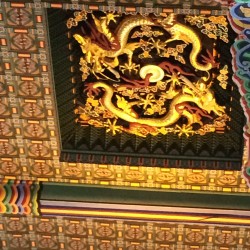The Jewel of Old Korea, Gyeongbokgung Palace was built in 1395 and the 7,700 rooms housed the Kings of the Joseon Dynasty, all of their households and the government. It was destroyed by fire during the Imjin War and abandoned for two centuries. Then in the 19th Century it was rebuilt only to be destroyed again in the 20th Century by Imperial Japan during it’s 1910-1945 occupation of Korea.
Today, the palace complex is being reconstructed to its original form covering 100 acres. It houses both the National Palace Museum and the National Folk Museum. Paths from the East Gate lead to The Blue House, the 62 acre complex that houses the executive office and official residence of the President of the Republic of Korea.
The doors of Geunjeongjeon, the Throne Hall, above, were open, but roped off. We couldn’t enter; but, we could see the elaborate decorations and furnishings. It was beautiful. Below you’ll see the picture I took of the center portion of the ceiling, ornately designed and covered in gold leaf.
Our guide is a romantic. She took us through the museums and told us about the place we’re standing in front of in the picture above. “It’s the Kissing Place” she announced as she took our camera and told us where to stand all the while describing couples centuries ago strolling around the lake, pausing to kiss near the Palace of Shining Happiness. Behind us is the Royal Banquet Hall, Gyeonghoeru.
There were monsters everywhere on the palace grounds. They were guarding the canal, the entrances, the tops of the roofs, the stairs and walkways. I would expect monsters to be frightening, especially guarding monsters. But, most of them were smiling. Lots of them were outright pleased with themselves and with us. It was so much fun to happen upon them, see what they were focused on, look at the expressions on their faces with so much detail and decoration and wonder what the artist had in mind.
It’s not difficult to imagine the royal sculptors having a wonderful time creating the many fanciful animals inhabiting the royal enclave or the royal children that were inevitably drawn in to watch the process.




